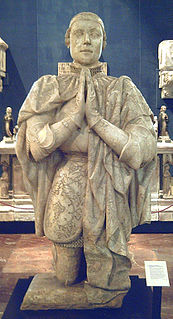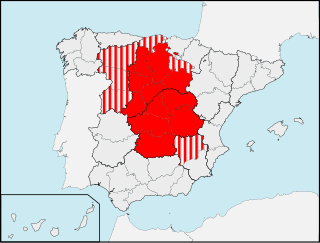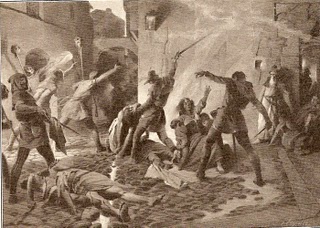
The Almohad Caliphate was a Moroccan Berber Muslim movement and empire founded in the 12th century.
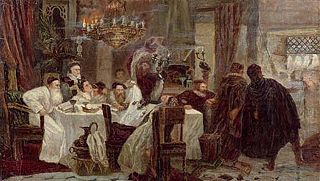
Marranos were Spanish and Portuguese Jews living in the Iberian Peninsula who converted or were forced to convert to Christianity during the Middle Ages, yet continued to practice Judaism in secret.

Henry III of Castile, called the Mourner, was the son of John I and Eleanor of Aragon. He succeeded his father as King of Castile in 1390.
Count Emicho was a count in the Rhineland in the late 11th century. He is also commonly referred to as Emicho of Leiningen or Emich of Flonheim. In 1096 he was the leader of the Rhineland massacres which were a series of mass murders of Jews that took place during the People's Crusade.
Religious antisemitism is aversion to or discrimination against Jews as a whole based on religious beliefs, false claims against Judaism and religious antisemitic canards. It is sometimes called theological antisemitism.
It is believed that the first Jews in England arrived during the Norman Conquest of the country by William the Conqueror in 1066. The first written record of Jewish settlement in England dates from 1070. They suffered massacres in 1189-90. In 1290, all Jews were expelled from England by the Edict of Expulsion.

Saint Vincent Ferrer, O.P. was a Valencian Dominican friar, preacher, who gained acclaim as a missionary and a logician. He is honored as a saint of the Catholic Church and other churches of Catholic traditions.
History of European Jews in the Middle Ages covers Jewish history in the period from the 5th to the 15th century. During the course of this period, the Jewish population gradually shifted from the Mediterranean Basin to Eastern Europe.

The Rhineland massacres, also known as the persecutions of 1096 or Gzerot Tatnó, were a series of mass murders of Jews perpetrated by mobs of German Christians of the People's Crusade in the year 1096, or 4856 according to the Jewish calendar. Some scholars consider the massacres to be the earliest known incident of antisemitism.
Jewish communities have existed across the Middle East and North Africa since Antiquity. By the time of the Muslim conquests of the 7th century, these ancient communities had been ruled by various empires and included the Babylonian, Persian, Carthaginian, Greek, Roman, Byzantine, Ottoman and Yemenite Jews.

The Alhambra Decree was an edict issued on 31 March 1492, by the joint Catholic Monarchs of Spain ordering the expulsion of practicing Jews from the Kingdoms of Castile and Aragon and its territories and possessions by 31 July of that year. The primary purpose was to eliminate their influence on Spain's large converso population and ensure they did not revert to Judaism. Over half of Spain's Jews had converted as a result of the religious persecution and pogroms which occurred in 1391. Due to continuing attacks, around 50,000 more had converted by 1415. A further number of those remaining chose to convert to avoid expulsion. As a result of the Alhambra decree and persecution in prior years, over 200,000 Jews converted to Catholicism and between 40,000 and 100,000 were expelled, an unknown number returning to Spain in the years following the expulsion.:17

The history of the Jews in Spain stretches back to Biblical times according to Jewish history. Spanish Jews once constituted one of the largest and most prosperous Jewish communities in the world. Spain was the unquestioned leader of world Jewry: scientific and philological study of the Hebrew Bible began, secular poetry was written in Hebrew for the first time, and for the only time between Biblical times and the origins of the modern state of Israel, a Jew commanded a Jewish army. This period ended definitively with the anti-Jewish riots of 1391 and the Alhambra Decree of 1492, as a result of which the majority of Jews in Spain converted to Catholicism and those who continued to practice Judaism were forced into exile, although many thousands returned in the years following the expulsion.
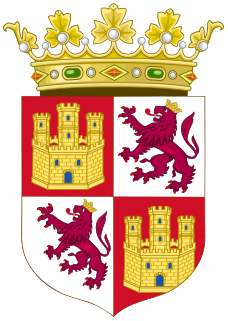
The House of Trastámara was a dynasty of kings in Spain, which first governed in Castile beginning in 1369 before expanding its rule into Aragon, Navarre and Naples. They were an illegitimate cadet line of the House of Ivrea.

The 1929 Arab riots in Palestine, or the Buraq Uprising, also known as the 1929 Massacres, refers to a series of demonstrations and riots in late August 1929 when a long-running dispute between Muslims and Jews over access to the Western Wall in Jerusalem escalated into violence.
Antisemitism in the history of the Jews in the Middle Ages became increasingly prevalent in the Late Middle Ages . Early instances of pogroms against Jews are recorded in the context of the First Crusade. Expulsion of Jews from cities and instances of blood libel become increasingly common in the 13th to 15th centuries. This trend peaked only after the end of the medieval period, and subsided only with Jewish emancipation in the late 18th to 19th century.[]
Radulphe was a French monk who, without permission from his superiors, left his monastery in France and travelled to the Rhine Valley during the Second Crusade (1147–49) where he preached "that the Jews should be slain as the enemies of the Christian religion." At Cologne Simon "the Pious" was murdered and mutilated; at Speyer a woman was tortured on the rack to persuade her to Christianity. Secular prelates tried to protect the Jews. Arnold, the Archbishop of Cologne gave them a fortified castle as refuge, and allowed them to arm themselves; the Crusaders refrained from attacking the castle, but killed any unconverted Jew that fell into their clutches. Henry I, Archbishop of Mainz admitted into his house some Jews pursued by a mob; the mob forced its way in, and killed them before his eyes.
This timeline of antisemitism chronicles the facts of antisemitism, hostile actions or discrimination against Jews as a religious or ethnic group. It includes events in the history of antisemitic thought, actions taken to combat or relieve the effects of antisemitism, and events that affected the prevalence of antisemitism in later years. The history of antisemitism can be traced from ancient times to the present day.
Ferrand Martinez was a Spanish cleric and archdeacon of Écija, most noted for being an antisemitic agitator whom historians cite as the prime mover behind the series of pogroms against the Spanish Jews in 1391, beginning in the city of Seville.
The Alhambra Decree was an edict issued on 31 March 1492 by the joint Catholic Monarchs of Castile and Aragon ordering practicing Jews expelled from their kingdom, territories and possessions by 31 July of that year. The primary purpose was to eliminate their influence on Spain's large converso population, and ensure its members did not revert to Judaism. Over half of Spain's Jews had converted as a result of the religious persecution and pogroms in 1391. Due to continuing attacks around 50,000 more had converted by 1415. Others who remained chose to convert to avoid expulsion. As a result of the Alhambra decree and the prior persecution, over 200,000 Jews converted to Catholicism and between 40,000 and 100,000 were expelled. An unknown number returned to Spain in the following years.:17




